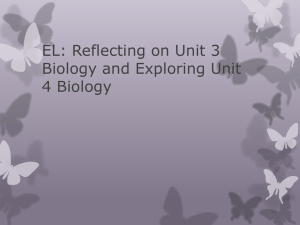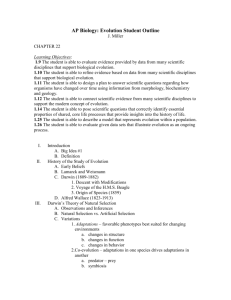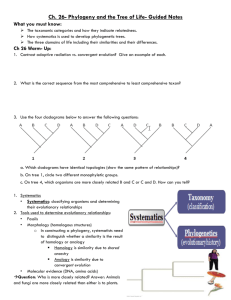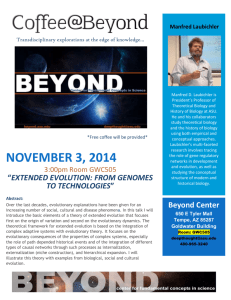Syllabus Evolution
advertisement
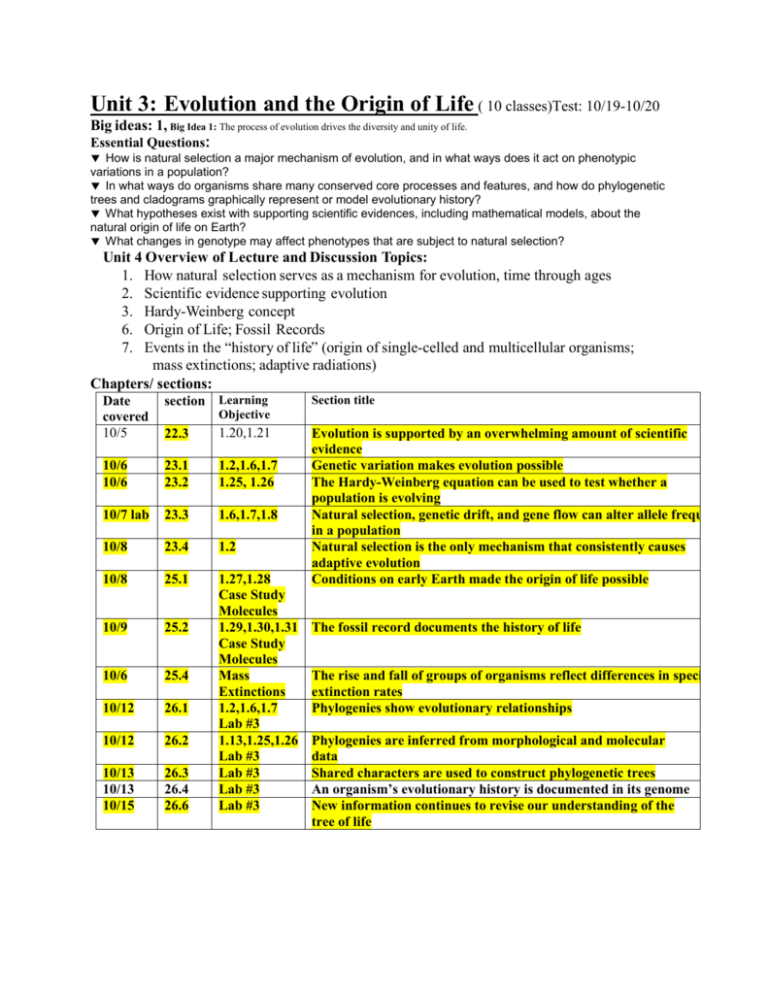
Unit 3: Evolution and the Origin of Life ( 10 classes)Test: 10/19-10/20 Big ideas: 1, Big Idea 1: The process of evolution drives the diversity and unity of life. Essential Questions: ▼ How is natural selection a major mechanism of evolution, and in what ways does it act on phenotypic variations in a population? ▼ In what ways do organisms share many conserved core processes and features, and how do phylogenetic trees and cladograms graphically represent or model evolutionary history? ▼ What hypotheses exist with supporting scientific evidences, including mathematical models, about the natural origin of life on Earth? ▼ What changes in genotype may affect phenotypes that are subject to natural selection? Unit 4 Overview of Lecture and Discussion Topics: 1. How natural selection serves as a mechanism for evolution, time through ages 2. Scientific evidence supporting evolution 3. Hardy-Weinberg concept 6. Origin of Life; Fossil Records 7. Events in the “history of life” (origin of single-celled and multicellular organisms; mass extinctions; adaptive radiations) Chapters/ sections: Date covered 10/5 section Learning 22.3 1.20,1.21 10/6 10/6 23.1 23.2 1.2,1.6,1.7 1.25, 1.26 10/7 lab 23.3 1.6,1.7,1.8 10/8 23.4 1.2 10/8 25.1 10/9 25.2 10/6 25.4 10/12 26.1 10/12 26.2 10/13 10/13 10/15 26.3 26.4 26.6 1.27,1.28 Case Study Molecules 1.29,1.30,1.31 Case Study Molecules Mass Extinctions 1.2,1.6,1.7 Lab #3 1.13,1.25,1.26 Lab #3 Lab #3 Lab #3 Lab #3 Section title Objective Evolution is supported by an overwhelming amount of scientific evidence Genetic variation makes evolution possible The Hardy-Weinberg equation can be used to test whether a population is evolving Natural selection, genetic drift, and gene flow can alter allele frequencies in a population Natural selection is the only mechanism that consistently causes adaptive evolution Conditions on early Earth made the origin of life possible The fossil record documents the history of life The rise and fall of groups of organisms reflect differences in speciation and extinction rates Phylogenies show evolutionary relationships Phylogenies are inferred from morphological and molecular data Shared characters are used to construct phylogenetic trees An organism’s evolutionary history is documented in its genome New information continues to revise our understanding of the tree of life Big idea #1 Laboratory Investigations #2: Mathematical Modeling: Hardy-Weinberg Old lab good ideas Population Modeling: http://www.bozemanscience.com/population-modeling Essential Characteristics of Life http://www.youtube.com/watch?v=bILvTe2_FEE&list=PLFCE4D99C4124A27A Evidence for Evolution http://www.youtube.com/watch?v=ooGKYediys8&feature=c4-overviewvl&list=PLFCE4D99C4124A27A INVESTIGATION #3 COMPARING DNA SEQUENCES TO UNDERSTAND EVOLUTIONARY RELATIONSHIPS WITH BLAST How can bioinformatics be used as a tool to determine evolutionary relationships and to better understand genetic diseases? Population simulation 4. Buskirk and Gillen, Inquiry in Action: Interpreting Scientific Papers, Article 7: “ “Tracking the Long-Term Decline and Recovery of an Isolated Population Activities: 1. Students will learn how to analyze cladograms and understand evolutionary relationships using the Basic Local Alignment Sequencing Tool. Students will analyze morphological details about a newly discovered fossil; hypothesize as to the position of the fossil in a pre-constructed cladogram, then test the hypothesis using BLAST. Once students become comfortable, they will use the tool to answer questions of their choice regarding gene sequences. Alternatively, students can explore and discover using Cold Spring Harbor DNA Learning Lab: DNA Subway. (Supports big idea 1; SP1, 3, 4, 5) [CR6] & [CR8] 2. Constructing a Phylogenetic Tree Using DNA Sequence Data Simulation: <http://www.accessexcellence.org/AE/> Students exchange the “ancestral DNA” with random mutations over time and make divergences into different evolutionary lines. A phylogenetic tree is constructed. Then, in a second part, students construct a phylogenetic tree of another group based strictly on nucleotide sequences of present-day organisms. (SP 1, 4, 5) [CR4a] 3. Evolutionary Time: The Geologic Time String <http://www.accessexcellence. org/AE> The Time String involves the use of a string. The string is 4.6 meters long, and each millimeter on the string represents 1 million years. Knots tied at distinct locations along the string represent extinctions, beginning of Eras, and so forth, in the geologic time table. (SP 7) 4. AP Biology POGIL AP Biology POGIL: 23 The Hardy-Weinberg Equation-S, 24 Mass Extinctions-S, Global Climate Change 5. Case Study of the Origin of Life: The Molecular Origins of Life: Replication or MetabolismFirst? 6. HHMI video: “Evolution” Students will view the lecture on artificial selection and a class discussion will follow. 7. Your Inner Fish 8. A Path Shrouded in Mystery 1960's to the mid 1990's Connected to enduring understandings: 1A. Change in the genetic makeup of a population over time is evolution 1B Organisms are linked by lines of descent from common ancestry. 1C Life continues to evolve within a changing environment. 1C Life continues to evolve within a changing environment. 1D The origin of living systems is explained by natural processes. 2D Growth and dynamic homeostasis of a biological system are influenced by changes in the system’s environment. 2E Many biological processes involved in growth, reproduction and dynamic homeostasis include temporal regulation and coordination. 3C The processing of genetic information is imperfect and is a source of genetic variation 4B Competition and cooperation are important aspects of biological systems. Learning objectives: on test Learning objective 1.2The student is able to evaluate evidence provided by data to qualitatively and quantitatively investigate the role of natural selection in evolution. [See SP 2.2, 5.3; Essential knowledge 1.A.1] Evolution Learning objective 1.4 The student is able to evaluate data-based evidence that describes evolutionary changes in the genetic makeup of a population over time. [See SP 5.3; Essential knowledge 1.A.2]Heredity & Evolution Learning objective 1.6The student is able to use data from mathematical models based on the Hardy Weinberg equilibrium to analyze genetic drift and effects of selection in the evolution of specific populations. [See SP 1.4, 2.1; Essential knowledge 1.A.3] Evolution Learning objective 1.7The student is able to justify data from mathematical models based on the Hardy-Weinberg equilibrium to analyze genetic drift and the effects of selection in the evolution of specific populations. [See SP 2.1; Essential knowledge 1.A.3]Evolution Learning objective 1.8The student is able to make predictions about the effects of genetic drift, migration and artificial selection on the genetic makeup of a population. [See SP 6.4; Essential knowledge 1.A.3]Heredity Learning objective 1.9The student is able to evaluate evidence provided by data from many scientific disciplines that support biological evolution. [See SP 5.3; Essential knowledge 1.A.4] Evolution Learning objective 1.10The student is able to refine evidence based on data from many scientific disciplines that support biological evolution. [See SP 5.2; Essential knowledge 1.A.4] Evolution Learning objective 1.12The student is able to connect scientific evidence from many scientific disciplines to support the modern concept of evolution. [See SP 7.1; Essential knowledge 1.A.4] Evolution Learning objective 1.13The student is able to construct and/or justify mathematical models, diagrams or simulations that represent processes of biological evolution. [See SP 1.1, 2.1; Essential knowledge 1.A.4] Evolution Learning objective 1.14The student is able to pose scientific questions that correctly identify essential properties of shared, core life processes that provide insights into the history of life on Earth. [See SP 3.1; Essential knowledge 1.B.1] Heredity Learning objective 1.17The student is able to pose scientific questions about a group of organisms whose relatedness is described by a phylogenetic tree or cladogram in order to (1) identify shared characteristics, (2) make inferences about the evolutionary history of the group, and (3) identify character data that could extend or improve the phylogenetic tree. [See SP 3.1; Essential knowledge 1.B.2] Evolution Learning objective 1.18The student is able to evaluate evidence provided by a data set in conjunction with a phylogenetic tree or a simple cladogram to determine evolutionary history and speciation. [See SP 5.3; Essential knowledge 1.B.2] Evolution Learning objective 1.19The student is able to create a phylogenetic tree or simple cladogram that correctly represents evolutionary history and speciation from a provided data set. [See SP 1.1; Essential knowledge 1.B.2] Evolution Learning objective 1.20The student is able to analyze data related to questions of speciation and extinction throughout the Earth's history. [See SP 5.1; Essential knowledge 1.C.1] Evolution Learning objective 1.21The student is able to design a plan for collecting data to investigate the scientific claim that speciation and extinction have occurred throughout the Earth's history. [See SP 4.2; Essential knowledge 1.C.1] Evolution Learning objective 1.25The student is able to describe a model that represents evolution within a population. [See SP 1.2; Essential knowledge 1.C.3] Heredity Learning objective 1.26The student is able to evaluate given data sets that illustrate evolution as an ongoing process. [See SP 5.3; Essential knowledge 1.C.3] Evolution Learning objective 1.27The student is able to describe a scientific hypothesis about the origin of life on Earth. [See SP 1.2; Essential knowledge 1.D.1] Heredity Learning objective 1.28The student is able to evaluate scientific questions based on hypotheses about the origin of life on Earth. [See SP 3.3; Essential knowledge 1.D.1] Heredity Learning objective 1.29The student is able to describe the reasons for revisions of scientific hypotheses of the origin of life on Earth. [See SP 6.3; Essential knowledge 1.D.1] Heredity Learning objective 1.30The student is able to evaluate scientific hypotheses about the origin of life on Earth. [See SP 6.5; Essential knowledge 1.D.1] Heredity Learning objective 1.31The student is able to evaluate the accuracy and legitimacy of data to answer scientific questions about the origin of life on Earth. [See SP 4.4; Essential knowledge 1.D.1] Heredity Learning objective 1.32The student is able to justify the selection of geological, physical, and chemical data that reveal early Earth conditions. [See SP 4.1; Essential knowledge 1.D.2] Review Learning objective 3.31The student is able to describe basic chemical processes for cell communication shared across evolutionary lines of descent. [See SP 7.2; Essential knowledge 3.D.1] Learning objective 3.32The student is able to generate scientific questions involving cell communication as it relates to the process of evolution. [See SP 3.1; Essential knowledge 3.D.1] Science Practices for AP Biology A practice is a way to coordinate knowledge and skills in order to accomplish a goal or task. The science practices enable students to establish lines of evidence and use them to develop and refine testable explanations and predictions of natural phenomena. These science practices capture important aspects of the work that scientists engage in, at the level of competence expected of AP Biology students. Skill Standard 1: Use representations and models to communicate scientific phenomena and solve scientific problems Chapters/ sections: 1.1 The student can create representations and models of natural or man-made phenomena and systems in the domain. 1.2 The student can describe representations and models of natural or man-made phenomena and systems in the domain. 1.4 . . .use representations and models to analyze situations or solve problems qualitatively and quantitatively. 1.5 . . .re-express key elements of natural phenomena across multiple representations in the domain. Skill Standard 2: Use mathematics appropriately. 2.1 . . .justify the selection of a mathematical routine to solve problems. 2.2 . . .apply mathematical routines to quantities that describe natural phenomena. Skill Standard 3: Engage in scientific questioning to extend thinking or to guide investigations within the context of the AP course. 3.1 . . .pose scientific questions. Science Practice 4: The student can plan and implement data collection strategies appropriate to a particular scientific question. 4.2 The student can design a plan for collecting data to answer a particular scientific question. Skill Standard 5: Perform data analysis and evaluation of evidence. 5.1 The student can analyze data to identify patterns or relationships. 5.2 . . .refine observations and measurements based on data analysis. 5.3 . . .evaluate the evidence provided by data sets in relation to a particular scientific question. Science Practice 6: The student can work with scientific explanations and theories. 6.3 The student can articulate the reasons that scientific explanations and theories are refined or replaced. 6.5 The student can evaluate alternative scientific explanations. Skill Standard 7: Connect and relate knowledge across var. scales, concepts and representations in/across domains. 7.1 . . .connect phenomena and models across spatial and temporal scales. 7.2 The student can connect concepts in and across domain(s) to generalize or extrapolate in and/or across enduring understandings and/or big ideas. YouTube Tutorials AP Biology-Evolution, evidence: https://www.youtube.com/watch?v=acx_-zfjBZM (6 min general introductions good) AP Biology: Evolution - The Biology Corner www.biologycorner.com/APbiology/evolution.html (Video) SciShow: Facts About Human Evolution. This unit requires participation in an asynchronous (online) discussion which will address current research on ... http://www.hhmi.org/biointeractive/explore-evolution The Biology of Skin Color Summary Penn State University anthropologist Dr. Nina Jablonski walks us through the evidence that the different shades of skin color among human populations arose as adaptations to the intensity of ultraviolet radiation in different parts of the world. SHORT FILM: (Duration: 18 min 58 sec) Play Short Film http://www.hhmi.org/biointeractive/making-fittest-got-lactase-co-evolution-genes-and-culture E. O. Wilson You don't stop laughing when you get old, you get old when you stop laughing." How to Fail 1. 2. 3. 4. 5. 6. 7. 8. 9. 10. 11. 12. 13. 14. 15. 16. 17. 18. 19. 20. 21. 22. 23. 24. 25. 26. Always arrive late. Never slip into your desk quietly. Instead, make a "big production" of entering the room by interrupting the class in session, dropping your books on the floor, etc. Better yet, don't have your books with you. Never bring a pencil to class. Always borrow someone's and forget to give it back. Never bring notebook paper. Let other people spend their money on paper and you just keep borrowing from them. Use the paper you borrowed to write a note. After you finish, make a big deal out of passing - or better yet, "throwing" it across the room to someone else disturbing as many people as possible. Never, ever, do your homework. The teacher will admire your consistency. Lose your textbook the first few weeks of school so you will have an excuse for not reading your assignments. During class, doodle on your notebook with a pen. Draw as much attention to yourself as possible by being loud, starting arguments, etc. Groan a lot. Say, "This is BORING!" loudly every five minutes or so, especially if the classroom is quiet. Ask, "Why do we have to do this stuff?" as often as possible. After the teacher says, "turn to page 36", say, "What page?" When your group or partner is depending on you, show up unprepared. Better yet, don't show up at all. Turn in all of your assignments incomplete. If you absolutely can't talk in class, fall asleep instead of working on your next assignment. When you get your test back with an "F", shout, "This isn't fair! The teacher hates me!" Never show concern about your grade until the last day of the grading period. Then ask the teacher for extra credit you can do to make up all the missing and failing assignments. If the teacher says, "No", throw a fit. Tease the student that sits in front of you by banging the back of their chair or making strange noises. Tease the student that sits in front of you by taking their assignment, notebook, or pencil. Remember to keep an innocent look on your face. Stay up as late as possible so you will be sleepy in class. Always chew gum loudly and leave candy wrappers lying in the room for someone else to pick up. If you have a report to do, always copy it word-for-word from the 'World Book Encyclopedia". If you decide to do homework, make sure you copy it from someone else. 27. If you decide to do your homework for fifth period English, be sure you do it during fourth period biology. 28. Don't take notes. If you followed items #4 and #5, this should not be a problem. "Remember that no one has the right to interfere with the learning of another." Following these rules will ensure that you fail and must repeat the class for a second time.

